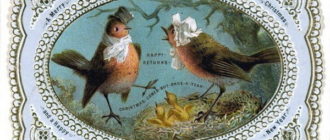
Paddling pool – a picture in which in 1869 Pierre-Auguste Renoir depicted the cafe of the same name, popular at that time, on the Seine. This place got its name not at all because of the presence of amphibian inhabitants of the reservoir, but because of the windy girls gathered there in bright outfits, whom the regulars called “frogs”.
In short and quick strokes, Renoir captured on canvas a carefree crowd on vacation on a hot summer day. He paid special attention to the detailed depiction of people: men in suits and ladies in fluffy dresses. Some take shelter from the sun under a tree on a small island, others go boating, and still others swim in cool water. Bright vibrating colors, the play of light captured in the reflections of the water – all this helped the artist to convey the joyful atmosphere of easy fun that reigned in the cafe.
Title of the painting: ” Paddling pool ” (fr. La Grenouillère).
Author: Pierre Auguste Renoir (1841-1919).
Year of writing: 1869.
Dimensions: 66.5 x 81 cm.
Style: Impressionism.
Genre: Landscape. Domestic.
Technique: Oil painting.
Material: Canvas
Location: National Museum of Sweden, Stockholm.

Pierre Auguste Renoir – French artist
Pierre worked in the second half of the 19th – early 20th centuries, becoming one of the founders of impressionism. He was born into a family of artisans and took his first steps in painting as an apprentice to a porcelain painter. He later began taking free lessons at the city’s art school, studying with Émile Signol and Marc Gabriel Charles Gleyre. In the latter’s studio, he made friends with other young artists who, like Renoir, dreamed of an art closer to life and free from past traditions.
The painting ” Paddling pool ” was created precisely in this early period of Renoir’s work. Then, together with Claude Monet (Oscar-Claude Monet), he began to work in the open air on the banks of the Seine in the town of Bougival. People came to the Lyagushatnik cafe to go boating, meet, communicate and enjoy the beauty of nature.
Everything here favored young painters: magnificent landscapes, the possibility of getting by train, and even the owner of the cafe, who took sketches as payment for lunch to hide the dirt on the walls behind them. This turned out to be very useful for Renoir and Monet, who were in a very tight financial situation.
Although the artists’ days were marred by a lack of money, the paintings around Bougival were vibrant and life-affirming. Both masters captured a single moment in time from the same position. But if Monet concentrated more on nature, trying to draw in detail all the details of the landscape, then Renoir was interested in people.
Painting Paddling pool by Auguste Renoir – a landscape in which personalities play the main role
Putting the crowd in the center of the composition, the artist carefully painted out the costumes, poses, activities and shades of moods of the regulars of the cafe, masterfully reflected the play of light on the faces of people in order to convey the atmosphere of carefree youth, cheerful flirting, and enjoyment of relaxation on a warm summer day.
Brief volumetric strokes, silvery reflections on the water, unmixed colors, a certain incompleteness – with such techniques Renoir managed to convey the fleetingness of the moment, fill the picture with life and movement. And the magnificent nature has become a picturesque frame for the stage. To contemporaries the picture seemed unfinished.
But today it is considered a textbook example of impressionism. Auguste Renoir spent two months at The Frog Room in 1869 and painted several works called La Grenouillère. One of them – “Bathing in the Seine” – is kept in the State Pushkin Museum of Fine Arts, and the second – in the Oskar Reinhart Museum in Switzerland.
The painting “Froggy” by Auguste Renoir is a random fragment of real life, masterfully captured on canvas, where every detail conveys a sense of harmony and joy of life. The masterpiece is currently in the National Museum of Sweden.






